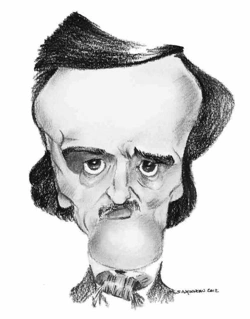Edgar Allan Poe I INTRODUCTION Edgar Allan Poe (1809-1849), American writer, known as a poet and critic but most famous as the first master of the short-story form (see Short Story), especially the psychological horror tale.
Publié le 12/05/2013
Extrait du document


«
the deciphering of a code.
“The Murders in the Rue Morgue” (1841), “The Mystery of Marie Rogêt” (1842-1843), and “The Purloined Letter” (1844) are regarded aspredecessors of the modern mystery, or detective, story ( see Detective Story).
Many of Poe’s tales are distinguished by the author’s unique grotesque inventiveness in addition to his superb plot construction.
Poe was unequaled in evoking an all-encompassing mood of horror through the rendering of setting and atmosphere.
The opening description in “The Fall of the House of Usher” (1839), for example,establishes a mood of gloominess that foreshadows the terrifying events to follow:
During the whole of a dull, dark, and soundless day in the autumn of the year, when the clouds hung oppressively low in the heavens, I had been passing alone, onhorseback, through a singularly dreary tract of country; and at length found myself, as the shades of evening drew on, within view of the melancholy House of Usher.
In “The Tell-Tale Heart” (1843) a maniacal murderer is subconsciously haunted into confessing his guilt.
Poe strived in this story for the single effect of total madness,which the narrator unintentionally confirms with every denial:
True!—nervous—very, very dreadfully nervous I had been and am! but why will you say that I am mad? The disease has sharpened my senses—not destroyed—not dulled themHow, then, am I mad? Harken! and observe how healthily—how calmly I can tell you the whole story.
Poe’s other masterpieces of horror include “The Pit and the Pendulum” (1842), a spine-tingling tale of cruelty and torture, and “The Cask of Amontillado” (1846), aneerie tale of revenge.
Although Poe believed that the short story was the most suitable form for fiction, he wrote a short novel, The Narrative of Arthur Gordon Pym (1838), in the hope of making some money.
Based on tales of South Sea exploration and adventures, the work combines realistic material with wild fantasies.
It failedto make him money because Poe claimed he had only edited Pym’s factual narrative, but the novel greatly influenced subsequent writers of the bizarre andphantasmagoric.
Microsoft ® Encarta ® 2009. © 1993-2008 Microsoft Corporation.
All rights reserved..
»
↓↓↓ APERÇU DU DOCUMENT ↓↓↓
Liens utiles
- Native American Literature I INTRODUCTION Leslie Marmon Silko Native American writer Leslie Marmon Silko is perhaps best known for her first novel, Ceremony (1977), a coming-of-age story about a young man of mixed Native American and white ancestry.
- William Blake I INTRODUCTION William Blake (1757-1827), English poet, painter, and engraver, who created an unusual form of illustrated verse; his poetry, inspired by mystical vision, is among the most original, lyric, and prophetic in the language.
- Poe Edgar Allan, 1809-1849, né à Boston (Massachusetts), écrivain américain.
- Jason (Iason) Greek The hero of one of the most famous Greek legends, often known as "Jason and the Golden Fleece," or "Jason and the Argonauts.
- Musical I INTRODUCTION George Gershwin American pianist, songwriter, and composer George Gershwin was one of the most important figures in popular song in the 1920s and 1930s.

































